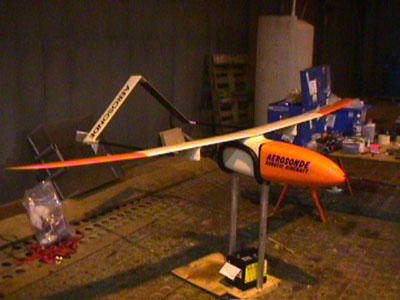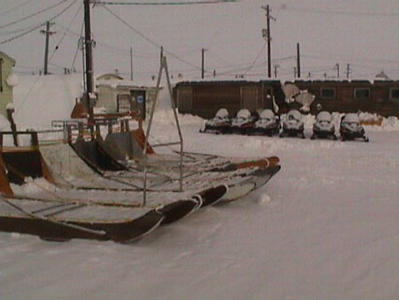5 April, 1999
5 April 1999
Follow-up to the Summer 1998 Deering Archeological Excavation
Aerosonde in Action--Global Climate Change Comes Home to Barrow in a Talk
by Dr. Jim Maslanik
Tim's Journal:
There is a little more Activity at the ARF (Arctic Research
Facility) this morning. Wildlife Biologists are starting to drift in from
all over to parcticipate in the whale census. We are off this morning with
Bernie Zak of ARM (Atmospheric Radiation Monitoring) to look at his
Aerosonde program. Zak has brought in an Australian team who will be flying
small-unmanned remote controlled airplanes over the Arctic Ocean. These
high-tech robots collect weather data and transmit it back to Barrow and
ARM's waiting equipment. These planes can travel up to 4000km and stay in
the air for up to 40 hours. The great advantage of the Aerosonde is that
unlike a weather balloon the Aerosonde can be sent to pin-point locations
and can return.
We spent the first part of our afternoon making contacts with
Arctic researchers, and the rest of our afternoon getting ready for our
presentations. In the next two days we have five presentations to make at
the Barrow high school, one live radio interview on radio station KBRW and
a public talk in the North Slope Borough Assembly Room.
In the evening we are taken by Glenn Sheehan of BASC (Barrow
Arctic Science Consortium) to a talk at the North Slope Borough Assembly
room. The talk entitled "Record Reductions In The Western Arctic Sea Ice
Cover In 1998" was given by Dr. Jim Maslanik a sea ice researcher and
climatologist from the University of Colorado. Dr. Maslanik explained that
6 of the 10 smallest ice covers in the Arctic Basin have occurred in the
past decade. He went on to state that in 1998 Arctic ice was 25% less than
the previous minimum. Dr. Maslanik stopped short of any long-range
predictions, but he did say that in the last decade Arctic ice has seen
reductions that average between 2 and 3 percent per year.
Aaron's Addendum:
The Aerosondes were by far the highlight of the day. These model
airplanes with ten-foot wingspans are able to fly across the Atlantic. The
ARM project was just a piece of all the research, of which archaeology is
only part, going on in Barrow. It is really neat to be able to see where
the actual science that we spend so much time reading about or watching on
television is actually being carried out. These are the real scientists
that are trying to determine, among other things, what the climate is
doing, what we are doing to the climate, how the atmosphere is behaving,
how the wildlife is responding, et cetera. In keeping with this global
climate change theme, even our archaeology fits in with the discoveries by
studying the way of life of those living long before the industrial
revolution and its ramifications. Dr. Jim Maslanik's talk about arctic sea
ice reductions was punctuated time and again by his wish for knowledge
concerning ice cover before his earliest data of 1954, which can be hinted
at through the use of accurate archaeology.
Not only the scientific proliferation but also concern was
demonstrated tonight as Dr. Maslanik spoke to concerned members of Barrow
about the sea ice. It was certainly interesting to see science come full
circle, from the actual data collection to its presentation to those who
most feel its effects and harbor the ability to usher its amelioration.

Aaron with the Aerosonde.

The Aerosonde.

Sleds and snow machines for the whale survey.
Contact the TEA in the field at
.
If you cannot connect through your browser, copy the
TEA's e-mail address in the "To:" line of
your favorite e-mail package.
|
